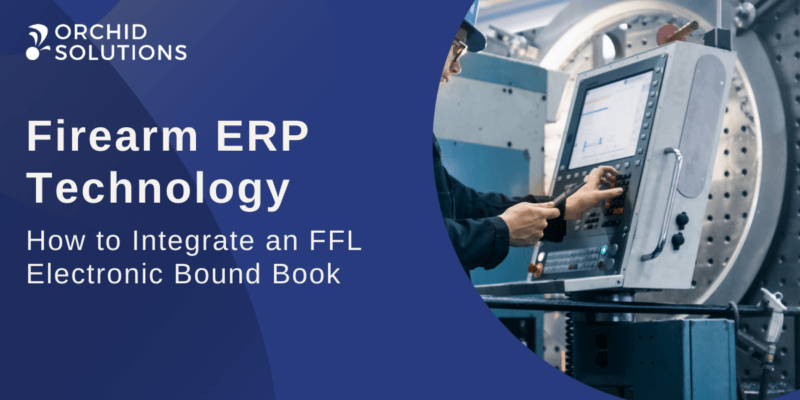Having served 75% of the top 40 firearms manufacturers, team Orchid has seen a significant increase in the deployment of ERP and eBound solutions amongst Type 07 and Type 10 FFLs. Regardless of size, requests from gun manufacturers have followed a common thread seeking to integrate their operational inventory objectives with ATF compliance. Their goal – to deploy an integrated technology platform that will increase accuracy and efficiency. And, while these integrations can take on many forms such as ERP-to-Laser or ERP-to-eCommerce, the need for ERP-to-Bound Book is most often at the heart of our customer discussions.For that reason, we’re taking the time to document the top three considerations for industry executives who seek to integrate an FFL Electronic Bound Book to a Firearm Manufacturing ERP.
#1 – Don’t Be A Guinea Pig
With the rise in demand for ATF eBound Book solutions comes a new breed of software providers claiming to be well experienced in ERP solutions. But know this, firearm manufacturing and ERP technology is very different than gun store operations and a retail Point-of-Sale solution. Specific to the manufacturing environment is Bills of Material, Routings, Demand Planning, MRP and MRP-II, Production Control, and more. Taking a retail solution and slapping it on a manufacturing ERP is dangerous and can be fraught with peril.
Therefore, selection of a manufacturing eBound Book solution should include a careful evaluation of the experience and credentials of your software provider – in the manufacturing space. And, an even more thoughtful understanding of their experience with firearm ERP implementations. We’ve seen firearm manufactures pay handsomely for their “API experienced” retail providers designing a solution for their environment. Take it from us, don’t be their guinea pig and do your research prior to buying any software in the manufacturing ATF space.
The proof is in the pudding – if the eBound software vendor is well experiences with NetSuite, Sage, SAP, Oracle, Microsoft 365, or even Epicor, the integration should be painless and very inexpensive. And from a timing perspective, the effort should be efficient, capable of operation in less than 30 days of purchase.
#2 – Nail Down Firearm Inventory and Customer/Vendor Data
Once integrated, everything that flows into your ATF eBound Book will start from the firearm manufacturing ERP. For that reason, it’s important to understand that the “source of truth” in your record keeping is in the heart of the ERP and begins in the Item Master, Customer Master and Vendor Master files. When combined with inventory transaction dates, it is this data that defines the contents of the acquisitions and dispositions to be inspected by the ATF.
Because the source of truth now lies within your operational software environment, the broader organization needs to be well educated on how engineering, purchasing and sales functions can impact your compliance. Take for example the manufacture, shipment and disposition of a new rifle. The regulated fields which include “manufacturer”, “model”, “caliber / gauge” and “type” mirror non-regulated fields used for customer facing purposes. Modification of these data elements beyond that which is engraved on the firearm (let’s say for sales purposes) can lead to inaccurate eBound Book data. Therefore, designing and deploying an integrated ERP / eBound Book solution needs to consider how the Item Master is designed. Such options include but are not limited to: (1) Having a second set of fields which are regulated and non-regulated; or (2) Aligning the data descriptions to serve multiple objectives at once.
#3 – Map Firearm ERP Inventory to ATF Transactions
Operational inventory transactions do not equal ATF regulated transactions (e.g., Acquisitions and Dispositions). And, while there is some overlap, not everything that happens in your factory is subject to recording in the eBound Book. Take for example, a firearm that was received under and RMA as a return for credit. Upon receipt, the box was opened and the firearm recorded in the ERP by the customer service team. Shortly thereafter, someone realized that it wasn’t a return for credit and instead was mailed to the factory for repair. In many ERP systems that would require some form of a financial adjustment which could be triggered behind the scenes or by backing out the transaction and rebooking it properly. So what happens to the Acquisition and Disposition records if you’re fully integrated? Are these subsequent, non-ATF transactions recorded in your eBound Book when they should not?
Having touched over 100 million firearm transactions since Orchid’s launch, we’ve seen too many companies launch without having properly mapped that which happens in their ERP to their eBound Book. The solution? Spend the time to map every operational activity in your factory to the eBound Book API. Or, consider reducing your risk by getting hold of a firearm ERP accelerator program that is designed to reduce risk and cost by relying on years of deep ERP experience.

0 Comments